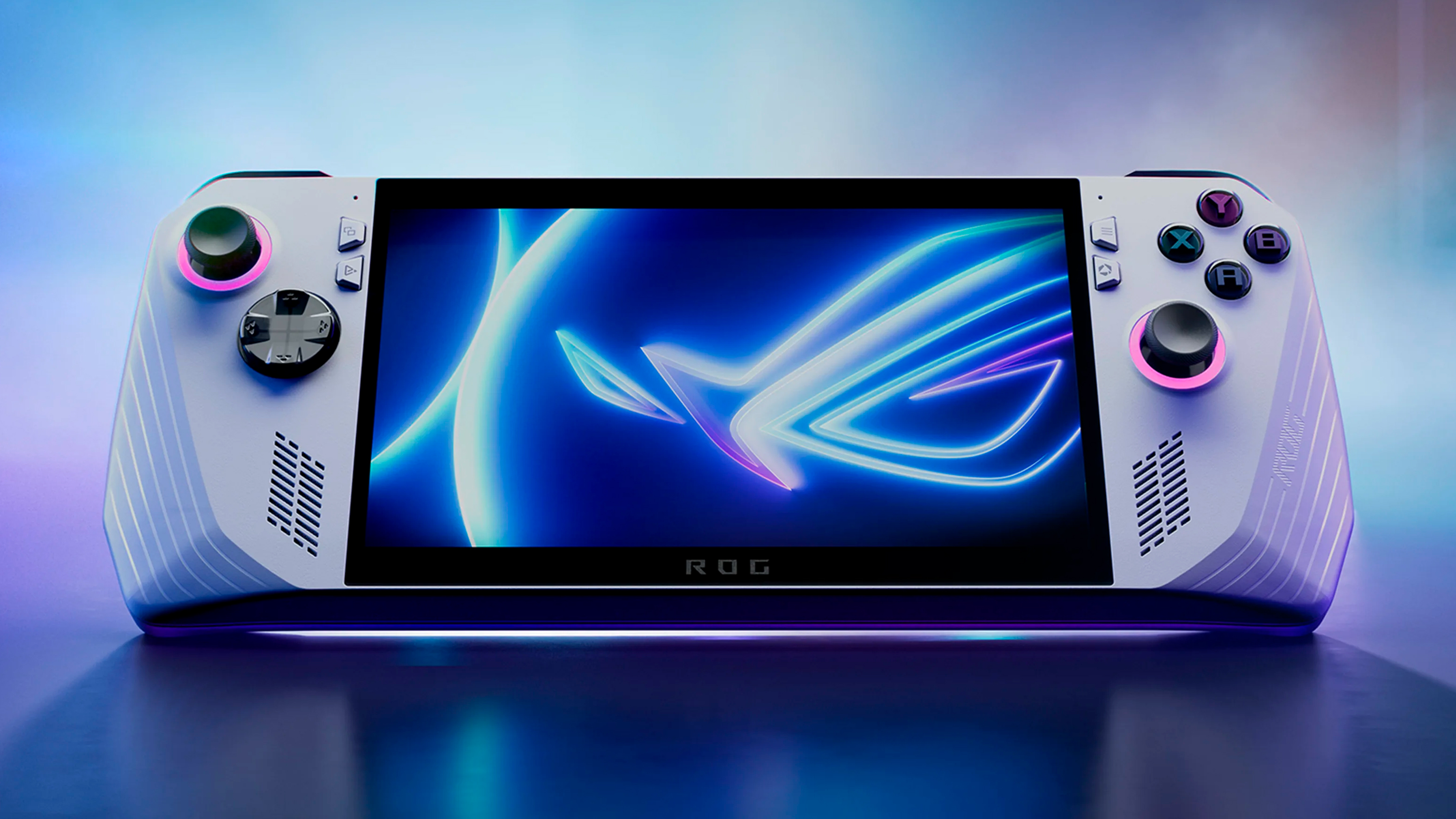Asus ROG Ally 2 leaks with AMD Z2 Extreme CPU and 64GB RAM — black variant features a dedicated Xbox button
The more toned-down white variant is seen with a seemingly new chip from AMD.

Microsoft's project Kennan handheld is finally materializing in the form of a variant of the ROG Ally 2 series, as revealed by reports by 91mobiles and Huang514613 at X. Asus is allegedly prepping two variants of its ROG Ally 2 lineup: a black model featuring a dedicated Xbox Button and a white model with toned-down specifications intended for the mainstream.
Project Kennan has been official for a while. While we lacked specifics about the handheld, this new leak should help fill the gaps. Once the model ID numbers were revealed, they were shortly linked to listings of the handhelds in the US FCC repository. The significant differences between both models mirror how the original ROG Ally varied, offering AMD's Z1 (with 4 CUs) and the more powerful Z1 Extreme (12 CUs) models, at a $100 price gap. Either way, Asus is still sticking to x86 roots for this handheld to maintain compatibility with existing software and games.
The Xbox Button on the black variant practically shouts Project Kennan. Despite the fanfare, it'll probably still run Windows 11, not a custom Operating System designed explicitly for handhelds. In addition, the added button probably serves to open the Game Bar, as you would on a PC. Let's wait for the official announcement to see if Microsoft has included other features and software-level optimizations.
RC73YA Z2 A 4C 6~20W 16GRC73XA Z2 Extreme 8C 15~35W LPDDRX-8533 32G M.2 2280🥰 https://t.co/IKKp6dgpAg pic.twitter.com/VHvqqC7yQRMay 7, 2025
Either way, under the hood, project Kennan reportedly carries AMD's Ryzen Z2 Extreme chip with eight cores (3x Zen 5 + 5x Zen 5c) / 16 threads, similar to the Ryzen AI 7 Pro 360, but offers a beefier 16 Compute Unit equipped iGPU (Radeon 890M), with a 15W-35W TDP. It supports 64GB of LPDDR5x-8533 memory, a 2TB NVMe SSD, and 100W charging. The display is said to include a touch-capable 7-inch LCD (likely IPS) featuring a 120 Hz refresh rate.
The white model is listed with a never-before-seen APU from AMD, carrying the OPN code: "100-000001835". This model gets 16GB of RAM, a 7-inch 120 Hz display, and supports 65W charging. Current data suggests the onboard APU, codenamed Aerith Plus, is a successor or potential refresh of AMD's Von Gogh found on the Steam Deck.
The leaker claims this APU, purportedly from AMD's Z2 series and dubbed "Ryzen Z2 A," has a quad-core layout and a 6W-20W TDP. Specifics such as the architecture and integrated GPU are unknown, but we should hear more from AMD/Asus at Computex.
Follow Tom's Hardware on Google News to get our up-to-date news, analysis, and reviews in your feeds. Make sure to click the Follow button.
Get Tom's Hardware's best news and in-depth reviews, straight to your inbox.

Hassam Nasir is a die-hard hardware enthusiast with years of experience as a tech editor and writer, focusing on detailed CPU comparisons and general hardware news. When he’s not working, you’ll find him bending tubes for his ever-evolving custom water-loop gaming rig or benchmarking the latest CPUs and GPUs just for fun.
-
Notton 64GB and Z2X are all fine and dandy, but it sounds expensive.Reply
Are we going to hit >$999 for a gaming handheld?
For reference
RoG Ally Z1: $599 (This model was a flop)
RoG Ally Z1X: $699 (It had card reader overheating issues that were never acknowledged)
RoG Ally X: $799 (Sticker shock, fixes problems in initial model, but it cracks in certain spots over time)
RoG Ally Z2: ???
RoG Ally Z2a: ???
Claw U5: $699 (Disastrous launch with buggy drivers that eventually got better)
Claw U7: $749, $799
Claw 7 AI+: $799
Claw 8 AI+: $899 (Sticker shock)
Lenovo Legion Go: $599 (poor battery life, weird shape controllers, mediocre software)
Steam Deck: $349, $399, $449 (Not the best of performance, but it just works)
Steam Deck OLED: $549, $649 -
GenericUser2001 Plenty of smaller brand handhelds have already crossed the $1000 mark. The Ayaneo Flip is $1139 on their website right now, as an example.Reply -
Giroro It looks less like an "Xbox" collaboration, and more like ASUS paid a licensing fee to Microsoft to use their controller design.Reply
Is this class of gigantic "handheld" consoles really so popular to warrant companies having so many on the market at the same time? It's rare to see even a Steam Deck when walking around an airport - and that is one of the smallest/cheapest/most popular models (and its still huge).
I have a hard time imagining anything bigger/more expensive than a Switch will ever see widespread adoption... and that includes Switch 2. -
thestryker Reply
I still don't see the point in 64GB for a handheld period so hopefully this is just an optional exercise. I'm pretty sure $900-1000 would be a spot on pricing guess wise for such a thing.Notton said:64GB and Z2X are all fine and dandy, but it sounds expensive.
Are we going to hit >$999 for a gaming handheld? -
usertests ReplyCurrent data suggests the onboard APU, codenamed Aerith Plus, is a successor or potential refresh of AMD's Von Gogh found on the Steam Deck.
This one is more interesting. It suggests that Z1 non-extreme was a bad choice for its tiny iGPU or cost if it's being abandoned for a higher clocked Van Gogh with older cores. -
thestryker Reply
Oh it was definitely always a bad choice due to the lopsided tradeoff. I think the big takeaway is that Z2 Go must just be a binned chip because it's basically a better Van Gogh so the only reason to enhance the latter is if it was enough smaller die size.usertests said:This one is more interesting. It suggests that Z1 non-extreme was a bad choice for its tiny iGPU or cost if it's being abandoned for a higher clocked Van Gogh with older cores. -
Notton Reply
Yeah, I sure hope they have a 32GB and/or 24GB model in a cheaper SKU.thestryker said:I still don't see the point in 64GB for a handheld psriod so hopefully this is just an optional exercise. I'm pretty sure $900-1000 would be a spot on pricing guess wise for such a thing.
I guess they could also make a 48GB model, but I doubt it would be a popular choice when a 32GB model will cover just about any game that runs on a handheld. -
usertests Reply
Definitely smaller and cheaper than the Z2 Go. And if a +100 MHz Aerith doesn't perform at least identically to the Steam Deck, the blame rests entirely with Windows or ASUS for its cooling/software, not the choice of APU.thestryker said:Oh it was definitely always a bad choice due to the lopsided tradeoff. I think the big takeaway is that Z2 Go must just be a binned chip because it's basically a better Van Gogh so the only reason to enhance the latter is if it was enough smaller die size.
In a better timeline, Mendocino would have used the same die as Van Gogh for better graphics (up to 8 CUs instead of 2 CUs), and the worst yields could have become the dual-core Athlon Gold 7220C and Athlon Silver 7120U. But still with more than 2 CUs. Even the Athlon Gold could have been a tri-core. They could have been producing tens of millions of the same die for low cost, sharing them between laptops, Steam Deck, and other handhelds.
Now we have the best testament yet to the staying power of the Steam Deck SoC: ASUS launching a brand new product with it in 2025, if the leak is correct. -
GenericUser2001 The rumors I am seeing after a bit of Google point to the "Aerith Plus" chip actually being made from a Krakan Point die, with 4 of the CPU cores disabled. Which of the four is unknown (Krakan point has 4 regular & 4 C cores), but at least the iGPU on that is RDNA 3.5 based vs the RDNA2 based Steam deck, so that should help a fair bit performance wise.Reply -
thestryker Reply
It should also have a lot more memory bandwidth as I believe the shipping manifests showed the same LPDDR5X-8533 as the Z2E. Unless Microsoft does something specifically to enhance gaming I expect frame pacing to still be better on the Deck.usertests said:Definitely smaller and cheaper than the Z2 Go. And if a +100 MHz Aerith doesn't perform at least identically to the Steam Deck, the blame rests entirely with Windows or ASUS for its cooling/software, not the choice of APU.